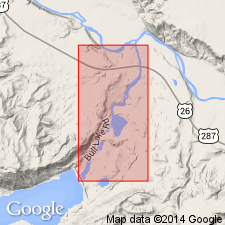
- Usage in publication:
-
- Sacajawea formation
- Modifications:
-
- Original reference
- Dominant lithology:
-
- Sandstone
- Limestone
- Breccia
- Shale
- AAPG geologic province:
-
- Wind River basin
Summary:
Pg. 650-660. Sacajawea formation. Lower part of Amsden is Mississippian in age and is here described and named Sacajawea formation to separate it from upper part of Amsden (Pennsylvanian). At type section, formation (units 14 and 15 of measured section) consists of basal unit, 2 to 11 feet thick, of red and buff sandstone and shaly sandstone, breccia in places, shale cave filling in places; and upper unit, 43 feet thick, of massive crystalline light-gray cherty limestone, with Ste. Genevieve fauna in lower 20 feet. Beds 10 to 13 (possibly Chester in age) in section are set off by unconformity above and are possibly separated from Sacajawea by unconformity below; these beds may be added to the Sacajawea if favoring evidence appears. Disconformable on Madison limestone. Fauna described. Age is Mississippian.
Type section: on Bull Lake Creek in south wall of canyon and in hogbacks in center of valley near Mount Sacajawea, Wind River Mountains, WY. Named from Mount Sacajawea at head of Bull Lake Creek. A store and inn of that name are on Yellowstone Park Highway near mout of Bull Lake Creek. Word is Shoshone name of Bird Woman, guide of the Lewis and Clark expedition.
Source: US geologic names lexicon (USGS Bull. 1200, p. 3370-3371).
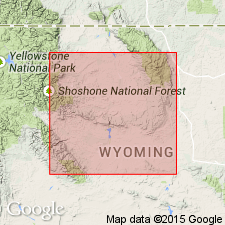
- Usage in publication:
-
- Sacagawea formation
- Modifications:
-
- Areal extent
- AAPG geologic province:
-
- Wind River basin
Summary:
Pg. 1203, 1204, 1211, 1212. Sacajawea formation. Measured sections show Sacajawea formation underlies Tensleep formation (redefined); locally separated from the Tensleep by limestone interval referred to as beds of Chester(?) age.
[Misprint (USGS Bull. 1200, p. 3370): manuscript published in GSA Bull., v. 50, no. 8; not no. 1.]
Source: US geologic names lexicon (USGS Bull. 1200, p. 3370-3371).
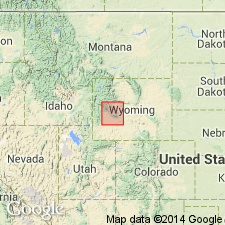
- Usage in publication:
-
- Sacagawea formation
- Modifications:
-
- Areal extent
- AAPG geologic province:
-
- Wind River basin
Summary:
Pg. 126 (fig. 2), 130-131. Sacagawea formation. Columnar section of formations exposed in and near Wind River Mountains shows Sacajawea formation, 100 to 200 feet thick, above Madison formation and below the Tensleep. Text states that on Bull Lake Creek 60 feet of laminated limestone without fossils lies with irregular contact on the Sacajawea and is overlain disconformably above. This sequence may constitute another formation, possibly of Chester age. Term Amsden not used in area of this report.
Source: US geologic names lexicon (USGS Bull. 1200, p. 3370-3371).
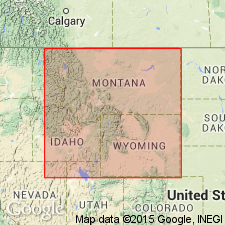
- Usage in publication:
-
- Sacagawea formation
- Modifications:
-
- Revised
Summary:
Sacajawea formation. Distinctive red-bed sequence, usually considered basal part of Amsden formation, constitutes persistent lithostratigraphic unit over much of Montana and Wyoming. In most areas, this unit rests disconformably upon Madison limestone. In central Montana, it overlies Heath formation of Big Snowy group. Underlies typical Amsden carbonates except in western Montana, where Amsden is absent and unit underlies Quadrant quartzite, and in eastern Wyoming, where Amsden lithologies have not been separated from the Hartville and Minnelusa. Thicknesses vary, without apparent pattern, from 5 feet in central Wyoming to 230 feet in Big Snowy Mountains. Name Sacajawea, which has been applied to Mississippian part of the Amsden in northwestern Wyoming, should be restricted vertically to include only the red beds, and extended laterally throughout area where those beds are recognizable. Term Amsden should be retained for the limestone and dolomites between the Sacajawea (restricted) and the typical sandstones of the Tensleep or its equivalents.
Source: US geologic names lexicon (USGS Bull. 1200, p. 3370-3371).
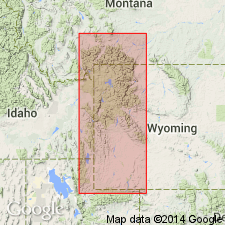
- Usage in publication:
-
- Sacajawea formation
- Modifications:
-
- Revised
- AAPG geologic province:
-
- Wind River basin
Summary:
Pg. 20, 21, 23-25. Sacajawea formation. Term Sacajawea should be adopted throughout western Wyoming for strata of Chester age below the Darwin sandstone member of Amsden formation and above top of Madison group [rather than only basal part of interval as defined by Branson].
Source: US geologic names lexicon (USGS Bull. 1200, p. 3370-3371); supplemental information from GNU records (USGS DDS-6; Denver GNULEX).
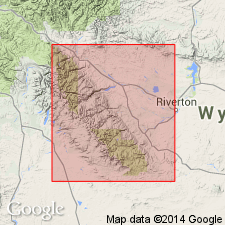
- Usage in publication:
-
- Sacajawea member
- Modifications:
-
- Revised
- Dominant lithology:
-
- Limestone
- Dolomite
- AAPG geologic province:
-
- Wind River basin
Summary:
Pg. 20, 21, 23-25. Sacajawea problem discussed. Confusion in interpretation and usage of term Sacajawea believed to have arisen largely as a result of original miscorrelatlon of type Sacajawea with Cherry Creek section and failure of most workers, including writer [Strickland], to recognize it. Believed that term Sacajawea should be used only for upper member of Upper Madison but should include the thin-bedded limestone and dolomites directly underlying Darwin sandstone and above the "massive crystalline limestone" of Branson (1937). This conclusion seems warranted on the basis of lithologic similarity with beds in unquestionable Madison strata and comment by Branson that beds referred to as Lower Amsden formation may be added to the Sacajawea if favoring evidence appears. This conclusion differs from those of earlier workers including the writer's (Strickland, 1956) who considered the term Sacajawea interchangeable with beds referred to as Lower Amsden. Type section described. Type Sacajawea as originally defined embraces only lower 50 feet or so of an 80- to 100-foot sequence of strata between the Darwin sandstone and typical looking Madison limestone. Age is Late Mississippian (Meramec).
Type section of Branson (1937): in SE/4 NW/4 NE/4 sec. 11, T. 2 N., R. 4 W., along hogbacks in middle of valley above Bull Lake, Wind River Mountains, Wyoming. Named from Mount Sacajawea at head of Bull Lake Creek. A store and inn of that name are on Yellowstone Park Highway near mout of Bull Lake Creek. Word is Shoshone name of Bird Woman, guide of the Lewis and Clark expedition.
Source: US geologic names lexicon (USGS Bull. 1200, p. 3370-3371); supplemental information from GNU records (USGS DDS-6; Denver GNULEX).
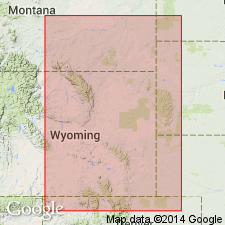
- Usage in publication:
-
- Sacajawea formation
- Modifications:
-
- Areal extent
- AAPG geologic province:
-
- Powder River basin
- Chadron arch
- Williston basin
- Denver basin
Summary:
Sacajawea formation of Minnelusa group. Recognized in Black Hills and Hartville uplift, southwestern South Dakota and eastern Wyoming. Correlated with Fairbank formation [Division VI of Hartville formation] of Condra and others (1940). Unconformably underlies Amsden formation of Minnelusa group; unconformably overlies Madison or Pahasapa limestone. Age is Late Mississippian and Early Pennsylvanian.
Source: Modified from GNU records (USGS DDS-6; Denver GNULEX).
For more information, please contact Nancy Stamm, Geologic Names Committee Secretary.
Asterisk (*) indicates published by U.S. Geological Survey authors.
"No current usage" (†) implies that a name has been abandoned or has fallen into disuse. Former usage and, if known, replacement name given in parentheses ( ).
Slash (/) indicates name conflicts with nomenclatural guidelines (CSN, 1933; ACSN, 1961, 1970; NACSN, 1983, 2005, 2021). May be explained within brackets ([ ]).

